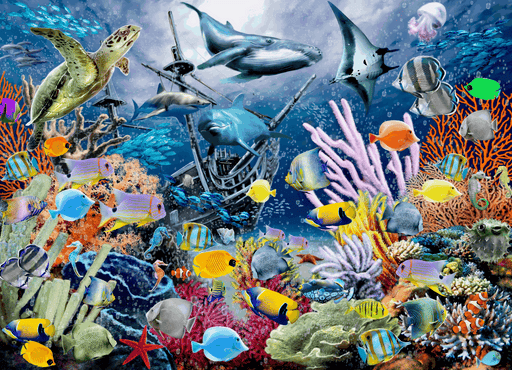
This puzzle, which consists of 9 pieces, is visually appealing and almost indestructible. It features 2 dolphins and 1 fish swimming in a sea full of waves. It promotes tactile development as well as problem solving skills. It is not recommended for children younger than 36 months due to the small parts.
Dolphins frolic in the water in this puzzle by Barbara Bayer
A dolphin puzzle is an excellent way to encourage children to explore water. This puzzle by Barbara Bayer features two dolphins swimming in the water. It includes 550 pieces as well as a sea life information card. This puzzle is ideal for home and office.
This puzzle will keep young children busy learning about dolphin life cycles. The bright and colorful images will appeal to all ages. The pieces are easy to fit together, so children will enjoy this puzzle for a long time. They make fun gifts for children.

Unique puzzles featuring animals for children 5 years and older
Children will enjoy unique jigsaw puzzle sets with animals. A great example of this is the Easy Rider 100 piece poster puzzle. Its over-sized pieces make it easy to handle. It comes with a fun fact sheet and an animal-shaped illustration to assist you in your search. The finished puzzle measures 24 inches high x 33 inches wide
There are plenty of animal-shaped jigsaw puzzle sets for kids of all ages. You can find a great puzzle pack for children from 3 to 5. There are many themes and options. A puzzle that looks like a seahorse would be a great choice for children who love animals. Puzzles that depict a bus and an ocean are also available.
Enhances problem solving skills
This educational toy is great for children to practice problem-solving and hand-eye coordination. The 252 pieces are non-toxic, eco-friendly, and odorless. This puzzle will aid in concentration, hand eye coordination, fine motor skills, as well as stress relief.
In order to solve this puzzle, you have to figure out how the dolphin moves. You will need to understand how it moves to solve the puzzle.

Improves letter- and color recognition skills
This puzzle is great to help children of all ages learn number, letter, color recognition skills. It also helps improve hand-eye coordination and concentration. It helps children use their hands to think critically and uses both of their fingers. It's made from sustainable rubberwood and painted non-toxic.
FAQ
Why do we need hobbies?
Hobbies can be a part of your life because they provide you with time to unwind, recharge, think creatively as well as the chance to exercise, socialize, and relax. These hobbies offer us the opportunity to learn new skills, develop valuable lifelong interests, and provide opportunities for us to do both.
Hobbies help us to find meaning and purpose in our lives.
They are often a great way to spend free time when you don't have much else going on.
They are fun!
If you don’t have the time to do a hobby, you likely don’t have any other hobbies.
You have many choices. If you don't have a hobby yet, then maybe you should start one today!
What are the most popular hobbies right now?
Popularity isn't always a good thing. It is often used to excuse mediocrity. It is a fact that most people don't have enough time to pursue hobbies they enjoy. They are too busy trying to make ends meet. You don't have the time to do all of these things. You could start your own company.
However, this isn't easy. Before you can make your idea a reality, there are many hurdles to overcome.
A hobby is a great option if you're looking to do something different than run a business.
Hobbies are not limited to creative pursuits. There are many kinds of hobbies. Some of these include:
-
Gardening
-
Cooking
-
Photography
-
Reading
What types of hobbies are suitable for introverts?
Introverts can focus on only one thing at a given time. They tend to prefer solitary activities such as reading, writing, playing music, watching movies, etc.
They enjoy being alone and spending time alone. They are not social creatures and don't want to be around people all day. They can even become bored when they're surrounded by people.
This is why introverts often choose hobbies that require them to be alone. For example, they may enjoy reading books, listening to music, taking photographs, painting, writing poetry, etc.
Introverts may even prefer to live alone. This allows them to focus on their hobby without being distracted by other things.
How do I get started with my new hobby?
To start a new hobby, you must first decide what type of activity you would like to do.
Passion is key once you have chosen your topic.
It is important to know the reason you want to begin a hobby. This will help you to find your purpose and direction.
Once you've decided what type of hobby you'd like to pursue, you can begin planning.
Think about what equipment you'll need to purchase.
Consider whether you need to attend classes or seminars.
You must ensure you have enough room for your hobby.
A club or group might be something you consider. These groups often offer advice and support.
Think about how much you'd need to spend on your hobby.
What are collection hobbies?
The most loved collections include books, movies and music.
Collect stamps, coins, cars, dolls and action figures as well as art supplies, tools, jewelry, watches, gadgets and furniture.
I believe you get the idea.
What are observation hobbies?
Observation hobbies are activities where you observe people doing what they do. This could be watching sports, reading books or going on holiday. It could also include observing others.
It's great to have observation hobbies because it helps you think creatively. This knowledge will be useful later in your work for others and yourself.
You'll find that if you're interested in something, then you'll have an easier time learning about it.
You might watch or read about football to learn more. Visit or take photographs to learn more about the art of photography.
You could also buy a guitar or play along online to music if you are a musician.
You could also choose to cook at home or go to restaurants if you are a good cook.
If gardening interests you, you could plant vegetables or flowers.
You can take a dance class, or just go out with your friends if dancing interests you.
If you like painting, you could paint pictures.
If you like writing, you could write stories or poems.
If you like drawing, you could draw pictures.
If you love animals, you could look after pets or work at a zoo.
You could choose to study biology, maths, chemistry, or physics if you are interested in science.
You can read books, listen to podcasts, or watch films if history interests you.
If you enjoy travelling, you might consider exploring your local area or traveling abroad.
Statistics
- The Role of the Mind in Sex, Dating, and Love: Men in the “humor” condition received phone numbers from 42.9% of the female participants and were refused 57.1% of the time. (time.com)
- I am 100% biologically a woman (discover.hubpages.com)
- Almost 80% of people claim to have no hobby. (hobbylark.com)
- In comparison, men in the “no humor” condition were refused 84.6% of the time and were only accepted 15.4% of the time. (time.com)
- A new survey by Pew Research Center of teens ages 13 to 17 finds that 36% of girls feel tense or nervous about their day every day; 23% of boys say the same. (pewresearch.org)
External Links
How To
How to Start Gardening
Gardening is one the oldest forms. It requires persistence, patience, and determination. You must choose a suitable location to start your garden. You can choose to have a large area or a small one in your backyard. Next, pick the type of plants that you would like. Do you prefer vegetables or flowers? Some people are passionate about growing herbs, while others like raising livestock like rabbits. Before you decide what crops to plant, you should think about how much space is available. If you live in a region that experiences cold winters then it is possible to grow fruits and berries.
After choosing what you want to plant you need to prepare your soil. The soil is crucial in determining whether your plants thrive or not. The soil should be rich in organic matter to provide nutrients for your plants' roots. Organic matter includes things like leaves, twigs, grass clippings, manure, and compost. After you have prepared the soil, you will need to add nutrients. The type of plant you intend to grow will dictate the amount of nutrients you need. To determine these values, you can use a fertilizer calculator online. Many fertilizers are on offer, so make sure that you know which one you are buying.
After you have prepared the soil and added nutrients, it is time to wait for your seeds germination. This process usually takes anywhere from 2 weeks to 3 months, depending on the weather and the temperature in your area. After your seeds sprout, it is important to water them frequently. Overwatering your plants can lead to problems. Ensure you give your plants enough water at regular intervals and avoid overwatering. Overwatering can cause root rot or fungal diseases. When watering your plants, remember that most plants require less water during the warm summer months than in winter. You should also remember that some plants will need to dry out once they have been watered. For example tomatoes should be kept slightly moist and not wet. Soggy soil is not a good choice for tomatoes. After they have finished flowering, they must go dormant. The time when plants stop producing new life and store energy for the next season is called dormancy. Dormancy is when the plant stops sending signals back to its roots for food production. During this period, plants continue to store energy. However, the plant will die if temperatures drop below freezing or there is insufficient sunlight.
Urban areas can limit your choices for plants. Concrete sidewalks, roads, buildings and parking lots are all common in urban areas. These blocks block sunlight from reaching ground level. Concrete absorbs sunlight and blocks the soil below from receiving adequate sun exposure. Many plants can't thrive in urban environments because they lack sunlight. Fortunately, there are still many plants that can thrive in an urban environment. Many perennials, trees, and shrubs are able to adapt to urban living. Many annuals can also grow indoors in pots. Container gardens can be used to grow greenery indoors year-round, no matter what the weather outside.
Now that you have decided where to place your garden, chosen what you will grow, and prepared your soil, you are ready to plant!